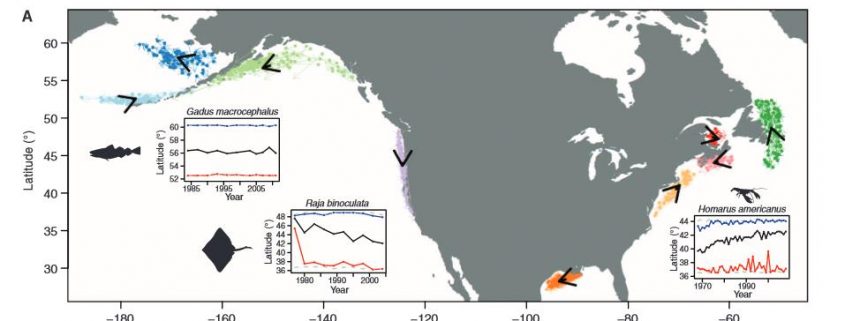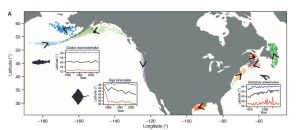Local Climate Velocities Drive Marine Species Shifts
by Jacob Jerome, RJD Intern
It is well documented that our climate on Earth is changing and new evidence suggests that marine organisms are adapting. This alteration by marine species is often characterized by adjusting their home range (i.e. where they live). As our climate warms, you would expect marine species to move away from the equator or into deeper water to adjust for the change in temperature. However, not all species are responding in this manner. Unlike other explanations that use biological distinctions among species as the catalyst, Pinsky et al (2013) looked at climate velocities as the driving force.
Climate velocity can be defined as the rate and direction that climate shifts across the landscape. The study aimed to use local climate velocities to explain why all of the species did not move as expected and why some were moving faster than others. North American scientific surveys and bottom-trawl data across nine regions from 1968 to 2011 were reviewed for the study. The data captured 128 million organisms belonging to 360 marine species. From this data, range shifts were measured for each species and then groups were formed based on their geographic region. It was noted that of the nine groups formed, four shifted poleward (i.e. away from the equator) and five shifted south.
Each group was then compared to its corresponding regional bottom temperature changes and it was found that this explained over half of the variation in shifts (It should be noted that one group was omitted due to geographic constraints). While increasing surface temperatures did not promote latitudinal shifts in groups, it did push groups deeper. Although this data is revealing, the researches wanted to examine how individual species responded to climate velocities rather than as a region.
To do this, they first had to recalculate climate velocities to accurately reflect each species’ home range. The results showed that there was variation in the movement from species to species and still a considerable amount did not shift as expected. Over all the species, they found that 74% shifted latitude in the same direction as climate velocity, and 70% shifted depth in the same direction. These results were similar for the species that did not shift as expected. Of those, 73% of shifts to lower latitudes and 75% of shifts into shallower water were explained by climate velocity. The rate at which species shifted was also compared to the climate velocity and it was found that on average, species do not lag behind the speed at which the climate moves.
To ensure that climate velocities were the leading factor in the shifts of species, the researchers added other variables that were related to species characteristics to a multiple regression model. The outcome showed that adding these variables, in addition to climate velocities, only increased the explained variation from 38% to 42%. They concluded that variation in climate velocities has a much greater influence on species shifts than variation in life history.
Understanding these differences in climate velocities may greatly enhance our ability to explain why species are shifting and help predict future events. There is already evidence that climate induced movements of commercially important species has caused conflicts between bordering fishing communities and has made traditional management approaches less effective. Acknowledging the above results will allow scientists and managers to anticipate the scale and magnitude of future events.






Reference for those interested:
Pinsky, M.L., Worm, B., Fogarty, M.J., Sarmiento, J.L., Levin, S.A. “Marine Taxa Track Local Climate Velocities.” Science. 341.6151 (2013): 1239-1242.